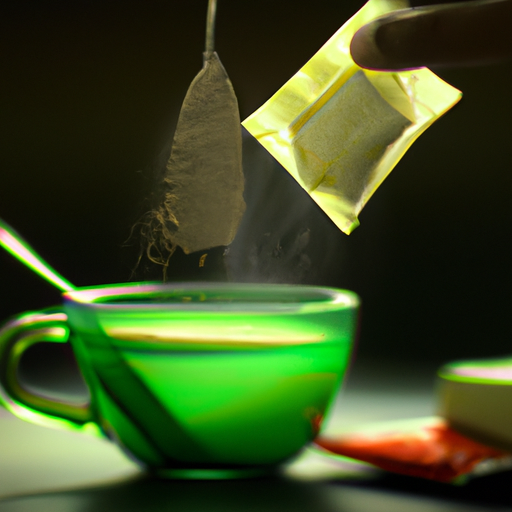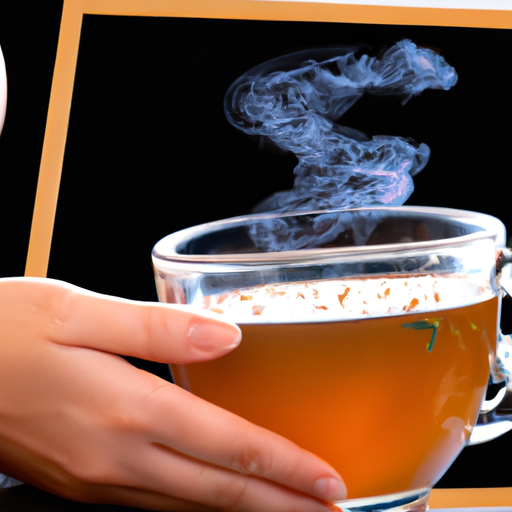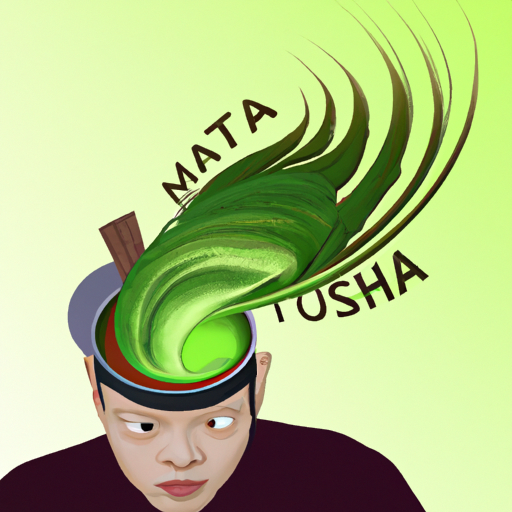Have you ever sipped on a matcha latte and longed to recreate it in your own kitchen without the need for an elaborate matcha whisk or pricey matcha powder? I’m here to tell you that it’s entirely possible! By utilizing a handful of basic ingredients, one of which is a simple tea bag, you can prepare a tasty and smooth matcha latte right at home.
I used to think that making a matcha latte required some kind of special equipment or skill, but after experimenting with different methods, I found that using a tea bag is a quick and easy way to make a perfect latte every time.
Not only is it more affordable than buying matcha powder, but it also eliminates the need for a matcha whisk, which can be intimidating to use for beginners. So, let me show you step-by-step how to make a delicious matcha latte with just a tea bag – you won’t believe how simple it is!
Key Takeaways
- Matcha latte is a delicious and healthy beverage that can be easily made at home using a few simple ingredients.
- Non-dairy milk options like almond, coconut, soy, and oat milk can be used to make the latte creamy and flavorful.
- Sweeteners like honey, agave nectar, and stevia can be added to the latte to enhance its taste.
- Matcha latte is a great source of antioxidants, caffeine, and L-theanine, which can boost energy, improve focus, and reduce stress.
Gather Your Ingredients
You’ll want to grab all of your necessary ingredients for your matcha latte, including a tea bag, milk, sweetener, and hot water. Before you get started, it’s important to choose high-quality ingredients to ensure your latte tastes as delicious as possible.
When it comes to the tea bag, you’ll want to make sure it’s a high-quality matcha tea bag, as this will impact the overall taste of your latte. If you’re unable to find a matcha tea bag, don’t worry! There are plenty of ingredient substitutions you can make to create a similar taste.
For example, you could use green tea bags or loose-leaf tea and add a pinch of matcha powder to the mix. Additionally, if you’re looking for a caffeine-free option, you could use a decaf green tea bag instead.
Ultimately, the key to a great matcha latte is using high-quality ingredients that you enjoy. Once you have your tea bag sorted, it’s time to move on to choosing your milk.
Choose Your Milk
When it comes to making a matcha latte, choosing the right milk is crucial to achieving a creamy and delicious drink.
As someone who loves dairy, I always go for whole milk or half-and-half as they add a rich and velvety texture to the latte.
However, there are also plenty of non-dairy options available, such as almond, coconut, soy, or oat milk, that can provide a unique flavor profile and cater to different dietary needs.
So, let’s dive into the world of dairy and non-dairy options and explore the best milk for your matcha latte!
Dairy Options
For a frothy and flavorful matcha latte, try using creamy coconut milk or rich almond milk instead of dairy. Not only do non-dairy options taste great, they also have numerous health benefits. Comparing dairy vs non-dairy, non-dairy options are often lower in calories, fat, and cholesterol. They are also a great option for those who are lactose intolerant or have a dairy allergy.
When it comes to matcha latte specifically, oat milk is an excellent non-dairy option. Not only is it creamy and delicious, but it also has a natural sweetness that pairs well with the earthy flavor of matcha. Oat milk is also a great source of fiber, protein, and vitamins. So, whether you choose coconut, almond, or oat milk, non-dairy options are a great way to make your matcha latte both delicious and healthy. Onto the next section about non-dairy options.
Non-Dairy Options
Opting for non-dairy milk in your matcha latte not only adds a delicious flavor, but also provides numerous health benefits. Matcha powder is known for its high concentration of antioxidants, vitamins, and minerals. When combined with non-dairy milk, the benefits are magnified.
Non-dairy milk options such as almond, coconut, soy, and oat milk are great choices for those who are lactose intolerant, vegan, or simply prefer a dairy-free lifestyle. When choosing the best brand of non-dairy milk for matcha latte, it’s important to consider the taste and texture, as well as the nutritional content.
Some brands may be too sweet or too thin, while others may have a chalky taste. My personal favorite is almond milk, as it has a rich and creamy texture that complements the earthy flavor of matcha powder. It’s also low in calories and high in healthy fats.
To warm your milk, simply heat it up in a small saucepan over low heat, stirring constantly to prevent burning. Once the milk is warm, pour it into a matcha-filled mug and enjoy the comforting warmth and delicious taste of your homemade matcha latte.
Warm Your Milk
First, heat up your milk in a saucepan or microwave until it reaches 160°F, which is the optimal temperature for a creamy and frothy matcha latte. Warm milk has numerous benefits that enhance the flavor and texture of matcha latte. It helps to dissolve the matcha powder and create a smooth consistency. Moreover, it brings out the natural sweetness of the milk and complements the earthy taste of matcha.
Here are four different milk temperatures to consider when making a matcha latte with a tea bag:
-
Cold milk: This will produce a thinner consistency and a milder flavor. It’s perfect for those who prefer a lighter taste and texture.
-
Room temperature milk: This will create a slightly thicker consistency and a more pronounced flavor. It’s ideal for those who want a balanced taste and texture.
-
Warm milk: This is the recommended temperature for a rich and creamy matcha latte. It’ll produce a velvety texture and a bold flavor that blends perfectly with matcha.
-
Hot milk: This will create a frothy latte with a stronger flavor and a thicker consistency. It’s perfect for those who want a bold and intense matcha experience.
Now that you’ve warmed your milk to the optimal temperature, it’s time to steep your tea bag. Simply place the tea bag in a cup and pour the warm milk over it. Let it steep for about 3-5 minutes to allow the matcha to infuse with the milk. As the tea bag steeps, the milk will absorb the flavors of matcha and create a deliciously creamy latte.
Steep Your Tea Bag
Once your milk is heated to the optimal temperature, it’s time to steep the tea bag in order to infuse the matcha flavor into the milk. Choosing the right tea bag is crucial for a delicious matcha latte. Look for high-quality tea bags that contain pure matcha powder, rather than blends that contain additives or artificial flavors.
When steeping the tea bag, be sure to follow the instructions on the package. Typically, you’ll want to let the tea bag steep for about 2-3 minutes in hot water before adding it to the milk. This will ensure that the matcha flavor is fully extracted and infused into the milk. You can also experiment with different steeping techniques, such as swirling the tea bag around in the milk or gently squeezing it to release more flavor.
With the tea bag steeped, it’s time to mix your matcha! In the next section, we’ll talk about how to whisk the matcha powder with hot water to create a smooth and frothy mixture. But before we move on, don’t forget to remove the tea bag from the milk. You can use a spoon or a strainer to do this, making sure to squeeze out any excess liquid from the tea bag for maximum flavor.
Mix Your Matcha
After steeping my tea bag, it’s time to focus on the matcha element of my latte. Matcha powder is the star ingredient here, and it’s what gives the latte its vibrant green color and rich tea flavoring.
I take a teaspoon of matcha powder and sift it through a fine mesh strainer to ensure there are no clumps. Next, I pour a small amount of hot water into the matcha powder and whisk it vigorously with a bamboo whisk until it forms a smooth paste. This is called the matcha concentrate, and it’s what gives the latte its distinct flavor.
Now that my matcha concentrate is ready, I add it to my cup of steeped tea and stir it together until it’s well combined. The result is a beautifully green and creamy matcha latte that’s packed with flavor.
- Sift matcha powder through a fine mesh strainer.
- Make matcha concentrate by whisking powder with hot water.
- Add matcha concentrate to cup of steeped tea.
- Stir until well combined.
As I take a sip of my freshly made matcha latte, I notice that it has a slightly bitter taste. This is where the sweetener comes in, which will balance out the bitterness of the matcha powder. In the next section, I’ll show you how to add just the right amount of sweetness to your latte.
Add Sweetener
Now it’s time to sweeten up this delicious matcha latte – who doesn’t love a little sweetness in their drink? There are different types of sweeteners you can use, depending on your preference.
For a natural sweetener, honey or agave nectar are great choices. They add a subtle sweetness without overpowering the earthy flavor of the matcha. If you prefer an artificial sweetener, you can use stevia or any sugar substitute of your choice.
When adding sweetener, it’s important to remember that matcha latte is already a healthy drink. Too much sugar can defeat the purpose of drinking matcha in the first place. So, start with a small amount and adjust accordingly. You can always add more if you want it sweeter.
Now that you’ve added your sweetener, it’s time to combine your milk and matcha. Remember to use your frother or whisk to create that creamy and frothy texture.
Combine Your Milk and Matcha
Let’s get ready to create a velvety, indulgent beverage that’ll make your taste buds dance with joy by combining the smooth, creamy milk with the vibrant, earthy matcha powder.
To begin, pour your desired amount of milk into a small saucepan and heat it over medium heat until it’s warm, but not boiling. Next, use a whisk to vigorously mix the matcha powder with a small amount of hot water until it forms a smooth paste. Finally, pour the matcha paste into the warm milk and whisk until it’s fully combined.
Flavor variations are a fun and easy way to switch up your matcha latte game. Some popular options include adding a splash of vanilla extract or almond extract to the milk before adding the matcha paste. Alternatively, you could use a flavored syrup like caramel or hazelnut to sweeten your latte and infuse it with a delicious flavor. Don’t be afraid to get creative and experiment with different combinations until you find your perfect matcha latte flavor!
If you don’t have access to matcha powder, fear not! There are alternative methods for making a matcha latte using tea bags. Simply brew a strong cup of green tea using your favorite tea bags, and then follow the same steps for heating and frothing your milk. Once your milk is warm and frothy, add a teaspoon of honey and stir until it’s dissolved.
Next, steep your green tea bag in the hot milk for 3-5 minutes, or until it’s reached your desired strength. Finally, remove the tea bag and pour the matcha-infused milk into your favorite mug.
Now that your milk and matcha are perfectly combined, it’s time to froth your latte for that extra touch of indulgence. But before we jump into that, let’s take a moment to savor the delicious aroma and gorgeous green color of our matcha latte.
Froth Your Latte
Now, it’s time to give your matcha latte that frothy finish.
I personally prefer using a manual frother, which gives me complete control over the frothiness and texture of the milk. However, an electric frother can also do the job just fine and is a great option for those who want a quick and easy way to froth their milk.
Let’s dive into the details of these two options and see which one suits your needs best.
Manual Frother
You can easily create a frothy matcha latte with a manual frother, adding a creamy texture to your tea. First, choose a high-quality matcha tea bag that suits your taste and preferences. Matcha is known for its numerous health benefits such as boosting metabolism, providing antioxidants, and improving mental clarity.
There are different types of tea bags for matcha latte, such as organic, ceremonial-grade, and culinary-grade. Each one has its unique flavor and aroma, so experiment with different types to find your favorite.
Once you have your tea bag, heat up your milk in a saucepan until it’s hot but not boiling. Pour your matcha tea bag into a cup and add your hot milk. Using a manual frother, mix the two together until you get a smooth and creamy texture. A manual frother gives you more control over the froth, allowing you to create a perfect matcha latte every time.
Now, if you want to take it up a notch, move on to the next step and learn how to create a frothy matcha latte with an electric frother.
Electric Frother
To create a velvety texture in your matcha-milk mixture, simply use an electric frother. This kitchen gadget will save you time and effort, while giving you consistent results every time. The benefits of using an electric frother are numerous. Firstly, it produces a finer foam, resulting in a smoother and silkier texture. Secondly, it saves time and effort, as it requires minimal manual labor. Lastly, it’s easy to use and clean, making it a convenient kitchen tool.
If you don’t have an electric frother, don’t worry. There are alternatives to create a frothy matcha latte. A handheld manual frother, also known as a milk frother or a whisk, can be used to froth your milk. Alternatively, you can use a blender or a French press to create a frothy texture. Remember to experiment and find the method that works best for you. Now that you’ve frothed your milk, it’s time to pour and serve your delicious matcha latte.
Pour and Serve
Next, simply pour the hot milk into the cup with the matcha tea bag and give it a good stir before enjoying your delicious matcha latte.
To make your matcha latte even more enjoyable, get creative with your serving choices. You can serve it in a traditional teacup or choose a unique mug that complements the flavor of your latte.
If you want to switch up the taste of your matcha latte, experiment with flavor variations. Add a dash of cinnamon or nutmeg to give your latte some extra warmth or try a drop of vanilla extract to give it a subtle sweetness. The possibilities are endless, so don’t be afraid to get creative and make the perfect matcha latte for your taste buds.
Now that your matcha latte is ready, take a moment to savor the flavors and enjoy the satisfaction of making a delicious beverage from scratch. With a little practice, you’ll be able to whip up a matcha latte that rivals any coffee shop’s version.
So sit back, relax, and enjoy your homemade matcha latte!
Enjoy Your Homemade Matcha Latte!
Now that your homemade matcha latte is ready, take a moment to indulge in the velvety texture of the milk and the earthy, slightly sweet taste of the matcha, transporting you to a cozy café in the heart of Japan.
Matcha is a type of green tea that’s grown in the shade, resulting in a higher concentration of antioxidants and caffeine. This means that not only does it taste good, but it’s also good for you!
One of the benefits of matcha is its ability to boost energy and focus. Unlike coffee, which can cause jitters and crashes, matcha provides a steady stream of energy throughout the day. It also contains L-theanine, an amino acid that promotes relaxation and reduces stress. So not only will you feel energized, but you’ll also feel calm and focused.
Another great thing about matcha is that there are so many different variations you can try. You can add honey or agave for sweetness, or even experiment with different types of milk like almond or oat milk. You can also adjust the amount of matcha powder to your liking.
Whether you prefer a stronger or milder taste, there’s a matcha latte recipe out there for everyone. So go ahead, get creative, and enjoy your homemade matcha latte!
Frequently Asked Questions
What is matcha and how is it different from regular green tea?
Matcha is a type of green tea that is grown and produced differently than regular green tea. It originated in China but was later adopted by Japanese tea makers, who turned it into the high-quality tea it is known as today.
Unlike regular green tea, matcha is grown in the shade, which causes the tea plant to produce more chlorophyll and amino acids, giving it a distinct flavor and vibrant green color. The leaves are then carefully harvested, steamed, dried, and ground into a fine powder.
Due to its unique flavor and color, matcha is used in a variety of culinary applications, such as in desserts, smoothies, and of course, matcha lattes. Its popularity has grown in recent years due to its health benefits, as it’s high in antioxidants and can boost energy and focus.
Can I use almond milk or another non-dairy milk instead of cow’s milk?
Switching to a plant-based diet can be challenging, especially when you crave your favorite dairy-based drinks. Luckily, there are alternatives like almond milk.
When it comes to making matcha latte with tea bag, almond milk can be a great substitute for cow’s milk. Not only is it vegan-friendly, but it also adds a nutty flavor that complements the earthy taste of matcha.
As someone who enjoys experimenting with different vegan options, I can confidently say that almond milk is a delicious addition to any matcha latte recipe. So, if you’re looking for a dairy-free alternative, give almond milk a try and enjoy the creamy goodness of matcha latte without compromising on taste.
What is the ideal temperature for warming the milk?
When it comes to making the perfect latte, one of the most important factors to consider is the milk temperature. Generally, the ideal temperature for warming milk is between 140-155°F. This range allows the milk to reach a creamy texture without scalding or burning.
To achieve the perfect temperature, it’s important to use a thermometer and monitor the milk closely. Additionally, frothing techniques can also impact the temperature of the milk, so be sure to use the right technique for your desired texture.
With the right milk temperature and frothing technique, you can create a delicious latte that will satisfy your taste buds and leave you feeling warm and cozy.
How long should I steep the tea bag for?
Steeping duration is an important factor to consider when preparing tea, regardless of the tea bag’s type. The ideal time to steep a tea bag varies, but generally, it should steep for around three to five minutes.
This duration allows the tea to release its full flavor and aroma, resulting in a rich and satisfying cup of tea. However, it’s important to note that some teas, such as green tea, require a shorter steeping time to avoid bitterness.
When preparing a matcha latte with a tea bag, it’s crucial to follow the instructions carefully to ensure that the tea is steeped for the appropriate amount of time to achieve the desired taste.
Are there any health benefits to drinking matcha latte?
There are several potential health benefits to drinking matcha latte, which is made from powdered green tea leaves. Scientific evidence suggests that matcha may help boost metabolism, improve focus and concentration, and reduce inflammation in the body.
Additionally, matcha is high in antioxidants, which can help protect against free radical damage and support overall well-being. However, it’s important to note that matcha is also high in caffeine, which can have potential drawbacks for some individuals, such as increased anxiety or disrupted sleep.
As with any food or beverage, it’s best to consume matcha in moderation and pay attention to how your body responds.
Conclusion
Well, that’s it! My homemade matcha latte is ready to be enjoyed. And let me tell you, it’s absolutely delicious.
The combination of the subtly bitter matcha and the creamy milk is just perfect.
It’s funny, just this morning I was thinking about how much I love matcha lattes, but I didn’t think I could make one at home. And now, here I am, sipping on one that I made myself using just a tea bag and some milk.
It’s amazing how easy it is to make something so delicious and satisfying. I can’t wait to make another one tomorrow morning!










